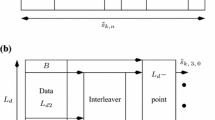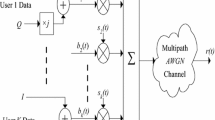Abstract
Uncoded orthogonal frequency division multiplexing (OFDM) transmission technique applied in a multipath environment has a bit error rate (BER) comparable with a narrowband radio channel because the fading of each subcarrier is frequency-nonselective. To overcome this behaviour and to reduce the BER, a combination of OFDM and CDMA has been proposed recently. In an OFDM-CDMA system the energy of each information symbol is spread over several subcarriers. Therefore a diversity gain can be obtained in a broadband fading channel.
In this paper we discuss the performance of OFDM-CDMA with coherent QPSK signalling over a frequency-selective Rayleigh fading channel. Channel estimation and demodulation are integral parts that determine the performance of the system. The method for channel estimation presented in this paper is based on a two-dimensional array of pilot symbols with second-order regression in the time domain and interpolation in the frequency domain. Quantitative comparison of four different detection algorithms in frequency-selective Rayleigh fading with noisy channel state information (CSI) will be presented in this paper: conventional correlation (equal gain correlation, EGC), orthogonality restoring correlation (ORC), ORC with a threshold in order to suppress subcarriers with low signal strength (TORC), and an iterative improvement based on a maximum likelihood approach. With TORC and iterative improvement a gain of approximately 9 dB over conventional OFDM can be obtained at a BER of 10−3 in Rayleigh fading.
Similar content being viewed by others
References
P. Jung, P.W. Baier, A. Steil, “Advantages of CDMA and spread spectrum techniques over FDMA and TDMA in cellular mobile radio applications,” IEEE Tr. VT 42, pp. 357–364, 1993.
T. O'Leary, “Terrestrial digital audio broadcasting in Europe,” EBU Technical Review, Spring, pp. 19–26, 1993.
R. Monnier, J.B. Rault, T. de Couason, “Digital television broadcasting with high spectral efficiency,” Proceedings International Broadcasting Convention, pp. 380–384, Amsterdam 1992.
C. Reiners, H. Rohling, “Multicarrier transmission technique in cellular mobile communications systems,” Proc. VTC'94, pp. 1645–1649, Stockholm 1994.
H. Sari, I. Jeanclaude, “An analysis of orthogonal frequency-division multiplexing for mobile radio applications,” Proc. VTC'94, pp. 1635–1639, Stockholm 1994.
J.G. Proakis, Digital Communications, McGraw Hill, 2nd Ed., Singapur 1991.
N. Yee, J.-P. Linnartz, “Controlled equalization of multi-carrier CDMA in an indoor Rician fading channel,” Proc. IEEE VTC'94, pp. 1665–1669, Stockholm 1994.
K. Fazel, “Performance of CDMA/OFDM for mobile communication system,” Proc. ICUPC, Ottawa 1993.
G. Fettweis, A.S. Bahai, K. Anvarim, “On multi-carrier code division multiple access (MC-CDMA) modem design,” Proc. IEEE VTC'94, pp. 1670–1674, Stockholm 1994.
A. Papoulis, “Probability, random variables, and stochastic processes,” 2nd Ed., McGraw-Hill, New York 1984.
Author information
Authors and Affiliations
Rights and permissions
About this article
Cite this article
Mueller, T., Brueninghaus, K. & Rohling, H. Performance of coherent OFDM-CDMA for broadband mobile communications. Wireless Pers Commun 2, 295–305 (1995). https://doi.org/10.1007/BF01099337
Issue Date:
DOI: https://doi.org/10.1007/BF01099337




